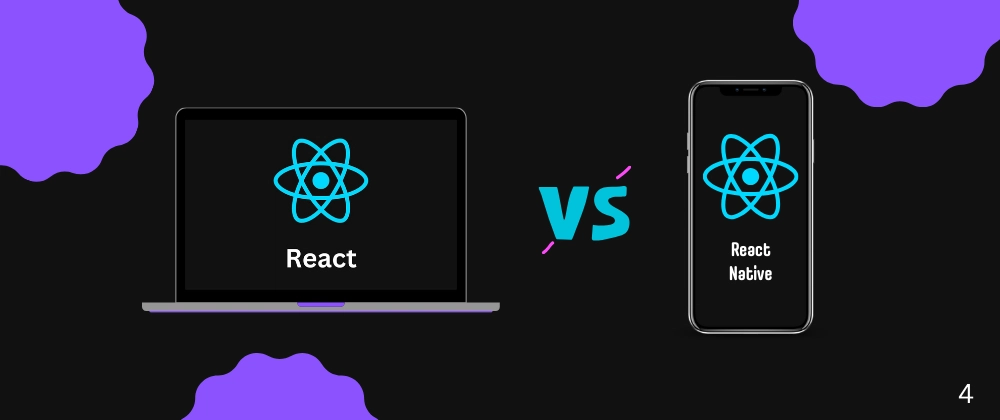For newcomers to web and mobile development, distinguishing between ReactJS and React Native can still be a challenge in 2025. With "React" in both names, it’s tempting to think they’re interchangeable. However, while they share a common heritage, these frameworks serve distinct purposes.
Developed by Meta (formerly Facebook), ReactJS and React Native remain leading open-source frameworks in their respective domains. ReactJS powers dynamic web applications, while React Native drives cross-platform mobile apps. Both leverage a component-based approach, enabling developers to streamline workflows and, in many cases, share code between web and mobile projects. In this blog post, we’ll dive into what sets ReactJS and React Native apart, their similarities, and how they’ve evolved.
What is ReactJS?
ReactJS, is a JavaScript library for crafting user interfaces, primarily for single-page applications (SPAs). Known for its efficiency in updating the DOM, ReactJS uses a declarative paradigm—developers define how a component should look, and React handles the rest. This minimizes boilerplate code, making it a favorite for building scalable, interactive web interfaces.
Components remain the backbone of ReactJS, reusable building blocks that render specific UI elements. These components communicate via a unidirectional data flow, ensuring predictable behavior. The virtual DOM continues to be a standout feature, optimizing updates by minimizing direct manipulation of the real DOM. Server-side rendering (SSR) capabilities, bolstered by frameworks like Next.js (now at version 15.x), further enhance initial load times and SEO performance.
In 2025, ReactJS has embraced advancements like concurrent rendering and improved hooks, making it even faster and more developer-friendly. Its ecosystem thrives with tools like React Server Components, which blur the lines between client and server, offering near-native performance for web apps.
What is React Native?
React Native, is Meta’s framework for building native mobile apps using React principles. It allows developers to write one codebase that targets both iOS and Android, a feature that’s only grown more robust with updates like the New Architecture (fully rolled out by 2024). This architecture, with its Fabric renderer and TurboModules, delivers smoother performance and better native integration.
React Native provides a library of pre-built, mobile-optimized components that mimic native UI elements, ensuring apps feel authentic on each platform. JavaScript remains the core language, though TypeScript adoption has soared, with over 70% of React Native projects leveraging it in 2025, according to community surveys. Features like hot reloading—now enhanced with real-time preview tools—accelerate development, while debugging utilities have matured with integrations into IDEs like Visual Studio Code.
The framework’s ability to bridge web and mobile development continues to attract developers. In 2025, React Native has also expanded support for wearables and foldable devices, reflecting the evolving mobile landscape.
Similarities between ReactJS and React Native
ReactJS and React Native share foundational traits that keep them aligned in 2025:
- Same Core React Library: Both rely on the React core, now more modular and performant than ever, ensuring consistent syntax and concepts across platforms.
- Component-Based Architecture: Reusable components remain central, with updates like memoization and lazy loading enhancing efficiency in both frameworks.
- JavaScript: JavaScript (and increasingly TypeScript) powers both, lowering the learning curve for developers transitioning between web and mobile. In 2025, tools like NativeWind further bridge the gap by bringing web-friendly styling paradigms (e.g., Tailwind CSS) to React Native, making the transition even smoother for JavaScript developers.
- JSX: JSX persists as the go-to syntax for defining UIs, blending HTML-like structures with JavaScript logic.
- Virtual DOM: While React Native adapts this concept for native rendering, both frameworks use lightweight abstractions to optimize updates.
- Thriving Communities: In 2025, both boast massive, active communities. ReactJS benefits from web-focused forums, while React Native’s community drives mobile innovation, with events like React Conf 2024 showcasing cross-platform breakthroughs.
Differences between ReactJS and React Native
Despite their shared roots, ReactJS and React Native diverge in key ways in 2025:
- Platform: ReactJS targets browsers, powering web apps, while React Native builds native iOS, Android, and emerging platforms like wearables.
-
Components: ReactJS uses HTML-based elements (e.g.,
<div>), while React Native employs mobile-specific components (e.g.,<View>,<Text>), now with richer native bindings via the New Architecture. - Styling: ReactJS uses CSS for styling, often with modern frameworks like Tailwind CSS, while React Native traditionally uses a JavaScript-based styling system optimized for mobile. However, with NativeWind in 2025, though it still differs from ReactJS’s browser-centric CSS model.
- User Interface: ReactJS offers boundless design flexibility for web, while React Native prioritizes native-like UIs, with 2025 updates improving animations and gestures.
- Performance: ReactJS excels on the web but lags on mobile compared to React Native, which leverages native rendering for superior speed on devices.
- Development Tools: ReactJS uses browser dev tools (e.g., Chrome DevTools), while React Native offers mobile-specific solutions like Flipper and Expo’s enhanced CLI, now standard in 2025 workflows.
Conclusion
ReactJS and React Native remain powerhouse frameworks for web and mobile development. Their component-based architecture and shared React foundation make them ideal for developers aiming to unify workflows across platforms. ReactJS continues to dominate web development with its speed and flexibility, bolstered by innovations like Server Components. Meanwhile, React Native’s focus on native mobile performance, expanded device support, and streamlined tooling cements its role in the mobile space.
Together, these frameworks empower developers to build high-quality applications with a single skill set, saving time and resources. Whether you’re crafting a cutting-edge SPA or a cross-platform mobile app, ReactJS and React Native are more relevant—and powerful—than ever in 2025.
Let’s Stay Connected! 🤝
If you found this post helpful, follow me for more tech insights, updates, and discussions:
✨ Thank you for reading! Feel free to share your thoughts or reach out—I’d love to hear from you. 🚀




Top comments (0)